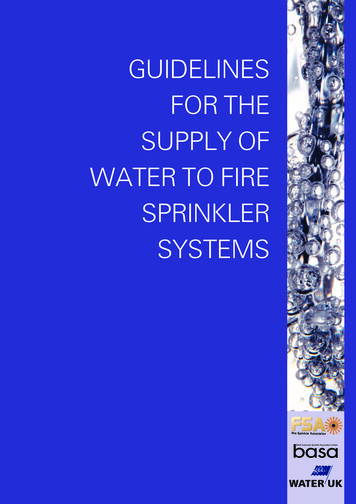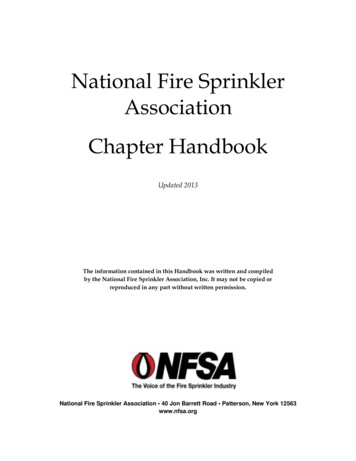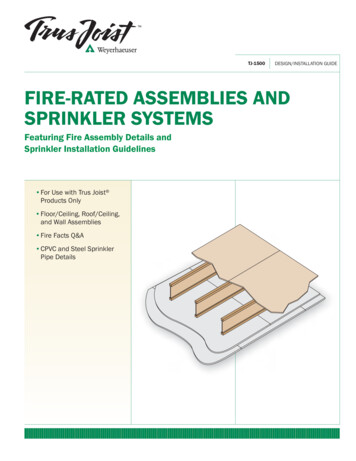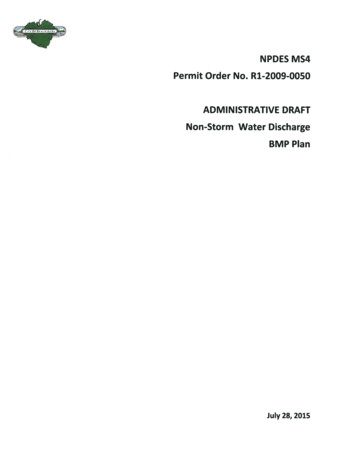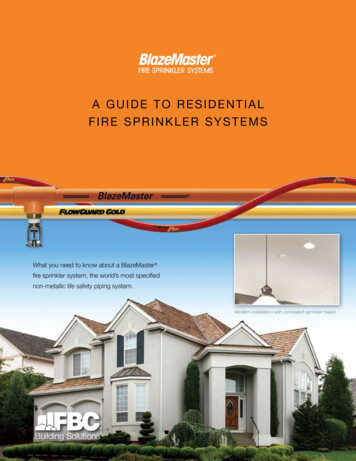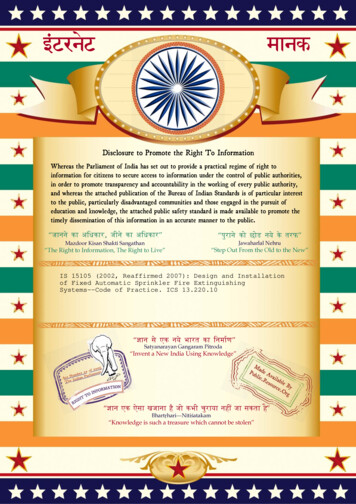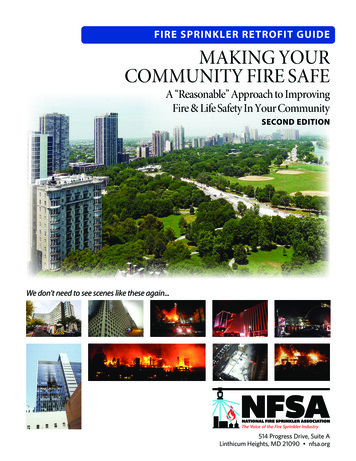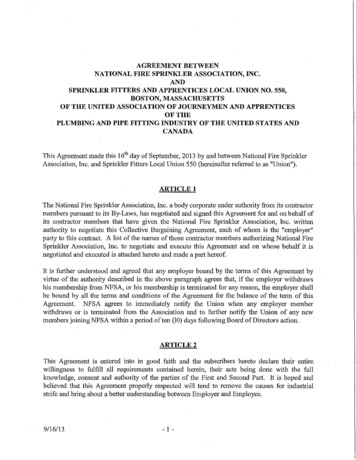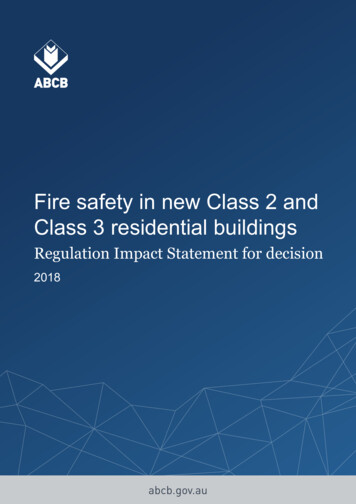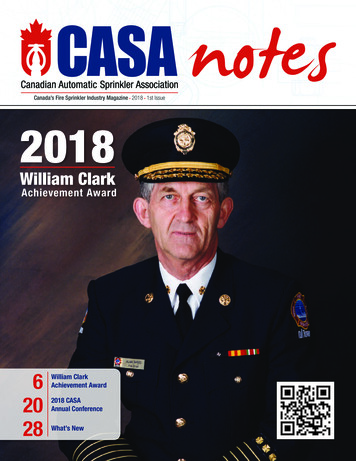
Transcription
Canada’s Fire Sprinkler Industry Magazine 2018 1st Issue2018William ClarkAchievement Award62028William ClarkAchievement Award2018 CASAAnnual ConferenceWhat’s New
TH EB E AU TYOFFLEXIBIL ITYRASCOFLEX FLEXIBLE DROPSOffering a wide variety of flexible hose lengths, K-factors, and bendingcapabilities, RASCOflex is fast, affordable, and easy to install. Hose lengths available in 24”, 31”,40”, 48”, 60”, and 72”cULus Listed and FM Approved (see RASCOflex sheetP/N 9999970510 for details)Versatile and simple bracket with secure mounting clampFind out more at www.reliablesprinkler.com
Inside This Issue.Canada’s Fire Sprinkler Industry Magazine 2018 1st IssueFire Sprinklers Save LivesBOARD OF DIRECTORS - 2017/2018OntarioRick Berwick, Chair, Classic Fire Protection Inc.AtlanticClaude Melanson, Viking Fire Protection Inc.OntarioGary Irving, Superior Sprinkler Co. Ltd.Manitoba/SaskatchewanCraig Ross, Vipond Inc.AlbertaCorey Gordon, Save All Fire Services Inc.British ColumbiaTim Killey, Fire Busters Inc.Associate Manufacturer/SupplierBryan Callaghan, Treasurer, Tyco Fire Protection ProductsNational RepresentativesMike Farren, Vipond Inc.Jim McCoubrey, Troy Life & Fire Safety Ltd.William Chanski, Tyco Integrated Fire & SecuritySteve Spearing, Viking Fire Protection Inc.PresidentJohn Galt, CASA Non-votingSTAFFPresident, John GaltCodes & Technical Services Manager, Jason RyckmanTraining and Apprenticeship, Jamie McKenzieNational Communications Manager, Matt OsburnAtlantic Regional Manager, Brian BickfordOntario Regional Manager, Jo-Ann GauthierWestern Regional Manager, Jamie McKenzieCASAnotes Editor / Event Planner, Debbie TomasicReception / Admin. / Labour, Lucy ArcuriAccounting, Jane LuThe Canadian Automatic Sprinkler Association is aNational Trade Contractor’s Association. It has existedin one form or another since the 1920’s, and wasincorporated under a Dominion Charter in 1961. Inits inception it recognized the Sprinkler Industry as aContracting Industry separate from any other trade.Voting membership, manufacturers, suppliers andsubscribers are brought into the Association. C.A.S.A.promotes, defends, enhances and improves the businessof installing and manufacturing the sprinkler devicesand systems. In doing so, the Association works closelywith Fire and Building Officials, Architects and othersfor the advancement of the automatic sprinkler art asapplied to the conservation of life and property fromfire. CASAnotes is published quarterly by the CanadianAutomatic Sprinkler Association, 315 Renfrew Drive,Suite 302, Markham, ON, L3R 9S7, Tel: (905) 477-2270,Fax: (905) 477-3611, Website: www.casa-firesprinkler.org,Email: info@casa-firesprinkler.org., Editor: Debbie Tomasic.This publication is free to all members of the Association.Subscriptions to CASAnotes and other industrypublications are available by contacting the C.A.S.A.office. The opinions expressed herein are those of theauthors and do not necessarily represent those of theCanadian Automatic Sprinkler AssociationReports / Articles4President’s Report20 2018 CASAAnnual Conferenceby John Galt6 2018 William ClarkAchievementAward Recipient8 Training andApprenticeship22Western Regional Reportby Jamie McKenzie24Ontario Regional Reportby Jo-Ann Gauthier26by Jamie McKenzieAtlantic Regional Reportby Brian Bickford10 Nominations Call for theCASA Board of Directors28What’s New31 Canadian FireSprinkler Hall of Fame12 Codes andTechnical Reportby Jason Ryckman14 NationalCommunications Reportby Matthew OsburnAdvertisers Index9AGF Manufacturing27Potter Electric Signal Company11Anvil International Canada2Reliable Automatic Sprinkler18Building Reports Canada5Reliable Automatic Sprinkler25FlexHead Industries Inc.19The Hose Monster Company16Globe Fire Sprinkler32Tyco Fire Protection Products23Greatario21Victaulic Company30Home Fire Sprinkler Summit15Viking Group, Inc.CASA Social Media resprinkler.org3
President’s Report John Galt, PresidentCanadian Automatic Sprinkler AssociationAt this time of writing, it appears that 2017 will see man hours upmodestly, reaching a new all-time peak for the country as a whole.Further we end 2017 with several successful initiatives, such asexpanded residential initiatives in the West, key legislative initiatives in Ontario,by way of Prompt Payment Bill 142 and Compulsory Certification.In addition, we will be working to better coordinate efforts between CASA andthe Quebec Corporation in 2018. (Corporation des Maitres Entrepreneures EnInstallations Contre l’Incendie (CMEICI)We also see improvements in Atlantic Canada man hours currently and into2018.The New Year got off to a great start with further expansions of legislative reformsfor Prompt Payment, modeled after Ontario’s legislation in New Brunswick andManitoba, with proposals for the same in Saskatchewan, Alberta and BC. Not tomention a promise for the same federally.The month of January saw media attention from comments by CASA’spartnerships association, CAFC board members on the subject of increasedcode requirements for Residential Fire Sprinklers right across Canada. Ourtremendous partnership with CAFC has equipped their members to be up todate with the latest in Sprinkler technology while knowledgeable on the everdecreasing costs of installation. With municipal water requirements greatlyreduced, the environmental impact of cO2 and water run-off, cut by upwardsof 80-90%, residential fire sprinklers just make so much sense for everyone inCanada.We remain optimistic about sprinkler demands into 2018, we will however, bewatching the confidence in new construction starts, forecast to grow in 2018,as the world proves to be a very unpredictable place, the effects of which ourNation is not immune.Some highlights to look for this year will be our Annual Conference in P.E. I., June25, with celebrity chef, Michael Smith involved with CASA delegates and theircompanions at our magnificent sea side setting.4CASAnotesThis year’s William Clark Achievement Award Recipient is the former TorontoFire Chief, Mr. Alan Speed. As you can see from Alan’s bio on page 6, he wasinstrumental in our shoulder to shoulder efforts with the Fire Service acrossCanada today. The partnership with our Nation’s Fire Service leader is centraltoday to extending the benefits for Fire Sprinklers to all Canadians where welive, work and play.Also with the ever increasing entry of women into the Canadian SprinklerIndustry, we will feature interviews and comments from women in ownershiproles, designs, sales and journey persons as well as apprentices from this laboursource.CASA will be announcing later this year some initiatives to help and removefurther barriers to women in our trade. CASA, last year along with our fellowNTCCC members, has been very supportive of the Federal Bill, C-243, toimplement a National maternity assistance program-a strategy to supportwomen who are unable to work due to pregnancy and the inability to beprovided reassignment-very key for women working in any construction trade.I was proud to speak in favour of this Bill, in several media interviews as CASAPresident and Chair of NTCCC, the spring of last year, along with meeting FederalMP, Mark Gerresten, of Kingston and the Islands, Ontario riding while on the Hillin Ottawa last year; the sponsor of the Bill. All this is part of taking barriers downfor 50% of our prospective work force in Canada, and promotes gender equalitywhile we better address a very real economic challenge to our work force.The weeks and months ahead will also see an expansion of Canadian specificCode and Standards applications through online training initiatives. Look formore on this from Jason Ryckman in upcoming CASAnotes and QR reports.What a great time to be in the Sprinkler Industry.
One Family. One Industry.One Source.For ALL of your fire protection needswww.reliablesprinkler.com
2018 William Clark Achievement Award RecipientAlan SpeedAlan Speed began his chosen career inMarch 1962 at age 18, when he joined theNottingham Fire Service in the U.K.Al was promoted to Chief of Administration 1988,Deputy Fire Chief 1989 and North York Fire Chief1992.He came to Canada in 1969 and became a NorthYork Fire Fighter in January 1970.He was appointed by the Ontario GovernmentTransition Team, November 1997, to become theFire Chief for the Amalgamating City of Toronto,accepting responsibility for bringing together 6Fire Departments and forming the largest full timeProfessional Fire Service Organization in Canada.He was promoted to Captain in 1979, then in 1983was promoted to District Chief and became theChief Fire Prevention Officer, promoted again in1986 to Platoon Chief.He spent 6 fulfilling years leading the progressivefire prevention programs and learned firsthand theimportance of Fire Sprinkler Systems.6CASAnotesDuring his career he served in numerousorganizations, including: Co-Chair of the Ontario Fire Marshals Public FireSafety Council. Chair of the Ontario Home Fire SprinklerCoalition. Chair of FireSAFE Ontario. President ofAssociation.theCanadianFireSafety President of the Institution of Fire Engineers.Ontario Branch. Member of Board of Directors, Habitat forHumanity, Toronto. Member of Toronto United Way AllocationsCommittee. Member of ULC Fire Council.
Three Generations - Al, Son Dave and Grandson Ryan Member of ULC Steering Comm. Research forthe Fire Service. Member of CSA Tech. Comm. Fire Protection forCANDU Nuclear Power Plants. Member of International NFPA Fire Forum,Boston. Member of Bldg and Fire Code Committees. Advisory Board, Canadian Centre for EmergencyPreparedness. Board of Directors, Canadian Fallen FirefightersFoundation. Honorary Chair, Salvation Army Red ShieldAppeal in 1997 and 2002. SalvationArmyInternationalManagement Training for NGO’s.DisasterChief Speed was honoured by his peers in 1997when he was the first recipient of the Fire Chief ofthe year award in Ontario, for his support of FireSafety and Fire Prevention Programs.He was also the recipient of the Fire Marshals Awardof Excellence in Fire Safety, 1998.He has authored numerous Fire Safety articles inlocal, national and international publications.He is a Graduate of numerous Institutions ofLearning, including:The Ontario Fire College; York University ProfessionalManagement Institute; Humber College BusinessCommunications and Employee Benefits; Institutionof Fire Engineers.He is also a Certified Municipal Manager in Ontarioand an Officer of the Order of St. John.Chief Speed retired from his lengthy fire servicecareer on April 30, 2003.In his retirement he has retained his enthusiasm asa Fire and Life Safety advocate and has a passion forfire prevention. He maintains a fervent belief that FireSprinklers are the missing piece of the puzzle in manyincidents involving the loss of life in a fire environment.He has worked closely with CASA to pursueCompulsory Trade requirements for Fire SprinklerFitters in Ontario. Also, he has lobbied, alongwith others, for changes to the OBC to require theinstallation of Fire Sprinkler Systems in occupanciesunder construction.Chief Speed has been a frequent Keynote speakerat numerous functions, both in Canada andinternationally. He was honoured to speak at a FireSprinkler Conference in Lisbon, Portugal, and alsoLake Louise. He has been the keynote speaker atnumerous Fire Chief Conferences in the U.K., U.S.A.and Canada.He has been an active lifelong member of TheSalvation Army and receives a great sense offulfilment from this avenue of service.He is married to wife Hazel and together they have 2children and 8 grandchildren. Daughter Andrea is aregistered nurse in the Addictions Recovery field andson Dave is the Fire Chief in Whitby, Ontario. Also,grandson, Ryan is a Fire Inspector in Richmond Hill.In their retirement, Hazel and Al enjoy spending timewith their family, when not travelling.casa-firesprinkler.org7
By: Jamie McKenzie, Western Regional ManagerCanadian Automatic Sprinkler AssociationTraining and ApprenticeshipOn my travels across our great country the hot topics of discussion atthe JTAC & the Western Regional Group meetings continues to be; Therecruitment of new Apprentices and how to locate and attract skilledjourneypersons to ensure an adequate workforce to meet our current and futureneeds. Most of the out of work boards in the various Local Union halls are void ofjourneypersons and apprentices looking for work. As an industry we have voicedour concerns of the on-going shortage of available skilled labour. The venues forthese discussions have been, Annual Conferences, Board meetings, Associationmeetings, Regional Group meetings, CASA Notes, JTAC meetings.Possible solutions discussed: Foreign workers First Nations Partnership with High School Recruitment Programs Helmet to Hard Hat Program Web based recruitment sites UA National website recruitment Advertise in various types of media (TV, Radio, Newspapers, etc )While there are varying methods and procedures to hiring new sprinklerapprentices across this country, the end result remains the same. The goal isto recruit and develop an apprentice in the hopes to support a highly skilledand profitable workforce through successful completion of their apprenticeshiptraining. We must strive to eliminate the misconception that a new apprenticeis simply "cheap labour" and at times disposable. There exists an obligationto actively evaluate, provide feedback and at times provide appropriatedisciplinary actions to ensure an apprentice stays on track and gets the mostof their apprenticeship prior to joining the workforce as a journeyperson. Animportant part of this process is some form of an evaluation to measure thedevelopment and performance of an apprentice. An evaluation can reinforce ajob well done, set achievable goals to motivate, identify areas for improvementor in some cases expose potential problems affecting their success in this trade.The evaluation can be supported by a standardized form completed by one ormore journeypersons responsible for supervision of the apprentice or simplya letter or email maintained for future reference. In any case, to provide thisfeedback to an apprentice gives accountability, value and recognition for theirefforts. By opening a means of communication through apprentice evaluationswe can reinforce how an apprentice can improve, how a journeyperson canhelp with this improvement and how a contractor can express the value of anapprentice as being more than "cheap labour".The Red Seal Program is a partnership between the Government of Canadaand the Provinces and Territories. Through the Red Seal Program, interprovincialstandards and examinations are developed and maintained through an industry8CASAnotesdriven process for the skilled trades. Today, the Red Seal endorsement is widelyrecognized and respected by Canadian industry as a standard of excellence.“The Red Seal Program provides confidence to both employers and consumersthat a tradesperson is skilled and knowledgeable. It also provides evidence thata Journeyperson has met a defined level of skill and that they are qualified to dotheir job,” said Larry Slaney, Director of Training for UA Canada. “The Red Sealendorsement on a provincial certificate facilitates mobility of trades workersand recognition of trade certification across Canada in the Steamfitter-Pipefittertrade, which is experiencing a huge demand for qualified workers.”The Red Seal Program has promoted labour mobility and help to standardizetraining and certification for skilled trades for over 50 years, developinginterprovincial requirements for 55 Red Seal designated trades. More than600,000 Red Seals have been issued to skilled tradespeople since the Red SealProgram’s inception.Training Issues from Various JTACs The NL JTAC is still focused on getting a certified instructor to deliverupgrading courses. The NB JTAC has members sitting on a working group tasked with thedelivery, monitoring and instruction of the Standard of Excellence. The Groupis made up of Contractors and Local 325 members. The NS JTAC/ Local 56’s Training Facility would like to thank the AMSmembers and CASA Contractors for their donations of fire protectionequipment. Local 853 and the Ontario JTAC continues to lead the way with their effortsto monitor the apprentice’s progress and if necessary, to intervene and offerto help them through a successful completion of their apprenticeship. MB JTAC continues to offer upgrading courses for it’s fitters. Alberta’s JTAC has and will continue to offer upgrade training to it’smembers. They welcome the new AFSA Chapter to Alberta and look forwardto the possibility of combining our efforts to education seminars, upgradetraining, Fire Sprinkler Summits, etc BC JTAC – PIC has new leadership as well as UA Local 170. They welcomethe new AFSA Chapter to BC and look forward to the possibility of combiningour efforts to education seminars, upgrade training, Fire Sprinkler Summits,etc continued on page 18
FREEZEPROTECTIONFOR DRY FIRE SPRINKLER SYSTEMSFrozen auxiliary drains are the main cause of dry fire sprinkler systemfailures in the winter. This year stop replacing the auxiliary drains thatfreeze and break with auxiliary drains that freeze and break.AGF’s COLLECTanDRAIN Model 5400 eliminates freeze-ups by providinga temperature controlled environment for the auxiliary drain increasingtheir capacity to collect condensation in the winter. Now is the time toinstall a Model 5400 so colder temperatures won’t put your dry firesprinkler system at risk.AUXILIARY w.collectandrain.comM5200
NOMINATIONS CALL FOR THECASA Board of DirectorsThe 2018-2019 Board of Director’s nominations will take place prior to our Annual General Meeting. Please be advisedthat your first call for nominations for the Board of Directors is now open. A slate of nominated Directors received will becirculated on April 12th with a last call for nominations. Nominations close on May 17th, 2018. Following that, but prior tothe AGM, we will also be electing officers (ie. Chairman, Secretary Treasurer, Executive Committee)The three areas up for re-election this year:1) Atlantic (Claude Melanson)2) Ontario “B” (Rick Berwick)3) Alberta (Corey Gordon)Please send your nominations to: Paul Harding (Nominating Chair) at Paulharding1944@gmail.comPLEASE NOTE: We will not be accepting nominations from the floor at the Annual General Meeting2018 ANNUAL CONFERENCEJune 24th - June 26th Charlottetown, PEIDelta Prince EdwardTo Register for the 2018 Annual Conference, please visit;www.casa-firesprinkler.org10 CASAnotes
Watch it slide into action at:www.74fp.comFEATURESBest Solution for Grooved Pipingin Warehouse Fire SystemsHighest Pressure Ratings of 450 psifor High Rise ApplicationsBy.I N T E R N AT I O N A LCANADAAll-in-one Design Requires No DisassemblyPre Lubricated GasketWet, Dry and Freezer ApplicationsPatented Gasket and Coupling TechnologyCompatible with Gruvlok & SPF FittingsMade in the USAFUNCTIONSUtilizing advanced engineering, Anvil introduces the SlideLOK 74FPrigid coupling. The coupling is the most rigid ready for installation couplingdesigned to reduce installation time. The coupling is truly unique,offering the safest procedure for installation. There are no loose parts.SPECIFICATIONSMore detailed information can be found online at www.anvilintl.com.519-426-4551 CanadaCS@anvilintl.com
By: Jason Ryckman, National Codes and Standards ManagerCanadian Automatic Sprinkler AssociationCodes & Technical ReportCSA B139-19 Public Review Section4.5 Diesel Fire PumpsPlease be advised that the public review draft for the CSA B139-19 InstallationCode for Oil-burning Equipment has just been posted. The draft contentcan be viewed at the following link: http://publicreview.csa.ca/Document/Manage/2807. You will have to register to review changes. Diesel fire pumprequirements can be viewed in section 4.5. The public review period will end onFebruary 19, 2018.Please share this communication with anyone who may be interested inreviewing the B139 draft. Comments will be accepted via the CSA PublicReview site.Update - Saskatchewan Adopting 2015 National CodesThe National Building Code 2015 (NBC 2015) and the National Fire Code 2015have been adopted and is in force in Saskatchewan as of January 1, 2018.Any questions concerning the application of the NBC and NFC, can bedirected to:Building Standards and Licensing100 - 1855 Victoria AvenueRegina, SK S4P 3T2Phone: 306-787-4113Email: building.standards@gov.sk.ca2018 British Columbia Building, Fire, Plumbing CodePublic Review Proposed ChangesThe Building and Safety Standards Branch of the Office of Housing andConstruction Standards in the BC Ministry of Municipal Affairs and Housing hasinvited code users and other stakeholders to participate in a public review toprovide feedback on proposed changes for the next edition of the BC Building,Plumbing, and Fire Codes. British Columbia will be adopting most of the 2015National Codes requirements into the 2018 BC codes with some changesspecific to British Columbia. These are noted in the public review proposedchanges. After reviewing these proposed changes, the BC Fire Code has aproposed change of interest 2.1.3.1., and A-2.1.3.1.(Deleted text / Added text):2.1.3.1. Fire Alarm, Standpipe and Sprinkler Systems 1) Except as otherwiseprovided in this Code, Ffire alarm, standpipe and sprinkler systems shall beprovided in all buildings when where required by and in conformance withArticle 1.1.1.1. of Division A the British Columbia Building Code.12 CASAnotesA-2.1.3.1.(1) The British Columbia Building Code is most often applied toexisting buildings when an owner wishes to rehabilitate a building, changeits use, or build an addition; or when an enforcement authority decrees that abuilding, or a class of buildings, be altered for reasons of public safety. It is notintended that either the British Columbia Building Code or the British ColumbiaFire Code be used to enforce the retrospective application of new requirementsin the British Columbia Building Code to existing buildings. Although the BritishColumbia Fire Code could be interpreted to require the installation of fire alarm,standpipe and hose and automatic sprinkler systems in an existing building forwhich there were no requirements at the time of construction, before theBritish Columbia Building Code was issued, it is the intent of the CanadianCommission on Building and Fire Codes that the British Columbia Fire Code notintended that the code be applied in this manner to these buildings.It is usually difficult to change structural features of an existing buildingwhen undertaking alterations or additions, but the installation of “active” fireprotection systems, such as alarms, sprinklers and standpipes, in existingbuildings may be possible. These systems may be considered as contributingto an adequate degree of life safety in cases where the structural features of abuilding do not conform to the British Columbia Building Code.Sentence 2.1.3.1.(1) is intended to address the installation of fire alarm,sprinkler and standpipe systems in existing buildings presently not so equipped,and in existing buildings that do not provide an acceptable level of safety tomeet the current installation standards specified in the British Columbia BuildingCode. Further, Iit is not intended that existing fire protection systems thatprovide an acceptable level of life safety be upgraded with each new editionof the British Columbia Building Code or in conjunction with the inclusion ofnew requirements not in force at the time that a building was constructed.The authority having jurisdiction is expected to use discretion in enforcing thisrequirement. The authority having jurisdiction may accept alternatives to strictcompliance with the NBC as provided for in Clause 1.2.1.1.(1)(b) of Division A.For buildings in which a sprinkler system is installed, Tthis provision isalso intended to direct Code users to Part 1 of Division A for the applicationof the British Columbia Building Code and primarily to Subsection 3.2.5.of Division B of the British Columbia Building Code, which specifies NFPA 13,“Installation of Sprinkler Systems,” as the appropriate standard for the designand installation of automatic sprinkler systems and provides several exceptionsand supplementary requirements (where, in certain cases, other provisionsin the British Columbia Building Code may also apply). However, where aspecific hazard, such as highly piled storage or the storage of flammable andcombustible liquids or rubber tires, is not addressed in the British ColumbiaBuilding Code, the applicable NFPA standards that contain design criteria for thesprinkler system required can be found in the British Columbia Fire Code.
The public review started on December 12, 2017 and ends on February 28,2018.The next editions of the British Columbia Codes are anticipated to be availablein 2018, with an effective date late in 2018.Alberta Testing Verification for Fire Suppression SystemsBuilding Code Interpretation StandataAlberta has issued a testing verification for fire suppression systems buildingcode interpretation standata in November 2017 to provide jurisdictions guidancewithin the ABC 2014 as to how a person or company provides verification tothe authority having jurisdiction (AHJ) about results of tests. This interpretationapplies to all fire suppression systems that are installed in buildings, including,but not limited to:1. Fire suppression systems for entire buildings or floor areas within buildings2. Fire suppression systems protecting commercial cooking ventilationsystems3. Fire suppression systems protecting spray rooms, spray boothsand spray areas for flammable and combustible materialspray operations. Please see the following website for mVerificationandTestingCertificates.pdfUpcoming Education Seminars, Meetings,and Speaking EngagementsIn-Class Education SeminarsWinnipeg, MB – Tuesday May 15th – Thursday May 17thTuesday May 15th – Fire Sprinkler Plan ReviewWednesday May 16th – Fire Sprinkler Plan ReviewThursday May 17th – Fire Pumps for Fire ProtectionCalgary, AB – Tuesday August 21st – Thursday August 23rdTuesday August 21st – Fire Sprinkler Plan ReviewWednesday August 22nd – Fire Sprinkler Plan ReviewThursday August 23rd – Fire Pumps for Fire ProtectionHalifax, NS – Tuesday October 23rd – Thursday October 25thTuesday October 23rd – Fire Sprinkler Plan ReviewWednesday October 24th – Fire Sprinkler Plan ReviewThursday October 25th – Fire Pumps for Fire ProtectionToronto, ON – Tuesday November 6th – Thursday November 8thTuesday November 6th – Fire Sprinkler Plan ReviewWednesday November 7th – Fire Sprinkler Plan ReviewThursday November 8th – Fire Pumps for Fire ProtectionVancouver, BC – Tuesday December 11th – Thursday December 13thTuesday December 11th – Fire Sprinkler Plan ReviewWednesday December 12th – Fire Sprinkler Plan ReviewThursday December 13th – Fire Pumps for Fire ProtectionOnline Education SeminarsFebruary 20, 2018 - Discussing Design ApproachesPresented by Louis Guerrazzi, E.I.T., Manager of Product StandardsChapter 11 of NFPA 13 (2016) provides a layout technician the tools todetermine the hydraulic design approach for a fire sprinkler system. Whilethe pipe schedule method is still permitted for small systems which meetthe requirements of Chapter 11, essentially all systems are now required tobe hydraulically calculated based on Section 11.2.3. This seminar will discussthe available hydraulic design options, including the density/area method, roomdesign method, and special design approaches, such as residential sprinklers,water curtains and a discussion on deluge systems.March 20, 2018 - Understanding the 2017 Edition of NFPA 25Presented by John Corso, Director of TrainingThis seminar will address significant changes to the 2017 edition of NFPA25, Standard for the Inspection, Testing and Maintenance of Water-Based FireProtection Systems, including an overview of the changes in the referencetables. This seminar will also discuss clarifications of existing rules, additionof newly required procedures, adjustments to reference tables and changes invarious time requirements for inspections and testing procedures.April 17, 2018 - An Overview of Corrosion in Sprinkler SystemsPresented by Mark Hopkins, P.E., Vice President of EngineeringThis presentation identifies design limitations and installation pitfalls whichinfluence corrosion in sprinkler systems. Topics will include how corrosionis commonly detected and why it is a problem. The basic forms of corrosion,its effects on system reliability, and failure mode concepts will be described.The basic framework for conducting corrosion investigations, factors forconsideration in determining whether to salvage or replace a system, andpossible corrosion management strategies will also be discussed.May 15, 2018 - 2015 and 2018 Changes to Building Codes forSprinkler ContractorsPresented by Jeff Hugo, CBO, Director of CodesBuilding codes reference installation standards and while layout technicians andcontractors know the installation standards well, there are numerous buildingcode rules that affect layout and system design. This course highlights changesto the 2015 and 2018 International Building Code, International Fire Code andNFPA’s Life Safety Code as it relates to the fire sprinkler contractor.June 19, 2018 - Hydrant Flow Tests per NFPA 291Presented by Roland Asp, Manager of Installation StandardsWater-based fire protection systems rely on a reliable source of water and themunicipal water system is a common source of this water. The characteristicsof a munic
The Canadian Automatic Sprinkler Association is a National Trade Contractor's Association. It has existed in one form or another since the 1920's, and was incorporated under a Dominion Charter in 1961. In its inception it recognized the Sprinkler Industry as a Contracting Industry separate from any other trade.
